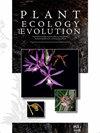淡水蜗牛上贡氏硅藻的类型物质分析及动物硅藻种群的比较
IF 1.3
4区 生物学
Q3 PLANT SCIENCES
引用次数: 0
摘要
背景和目的——Hustedt(1942)最初以Gomphonia tackei的名字描述了来自德国的Gomphophenia tackei。由于细胞大小小,并且缺乏来自该类型材料的扫描电子显微镜(SEM)图像,它经常与该属的其他物种混淆,尤其是与G.stoermeri混淆。本文通过对中欧地区几种表生代种群的形态资料和类型的分析,提出了塔基G.tacei的详细形态特征。材料和方法——本研究中的材料是从淡水蜗牛Lymnaea stagnalis、Planorbarius cornus和Planorbis Planorbis的外壳中收集的。此外,为了明确物种识别,使用光学和扫描电子显微镜分析了鹅膏菌的类型材料。关键结果——在研究材料中证实了鹅膏菌的存在。活蜗牛的外壳表面记录到的硅藻数量最多(高达19%),而在空壳上,硅藻似乎并不存在,或者数量很少。阀瓣通常为棒状,顶端圆形。瓣膜经常在环带视图中观察到,通常成对结合在一起。研究群体中的瓣膜长度为7–29µm,瓣膜宽度为3–4µm,条纹密度为每10µm 25–29条纹。在类型人群中,瓣膜长度为7.5至27µm,瓣膜宽度为3.0至4.0µm,纹密度为每10µm 23至29条纹。条纹由每个条纹2-4个细长到圆形的乳晕组成。在顶端,条纹由一个乳晕组成。细胞通过其足杆附着在基质上。结论-已发表的塔氏鹅膏菌的插图并不总是正确地代表该物种。单个细胞通过分泌的粘液附着在基质上,可能是通过其位于足柱上的乳晕或束带孔。本文章由计算机程序翻译,如有差异,请以英文原文为准。
Analysis of the type material of Gomphosphenia tackei (Bacillariophyceae) and comparison to epizoic diatom populations on freshwater snails
Background and aims – Hustedt (1942) originally described Gomphosphenia tackei from Germany under the name Gomphonema tackei. Because of the small cell size and the lack of scanning electron microscopy (SEM) images from the type material, it is often confused with other species from this genus, especially with G. stoermeri. The aim of this paper was to present detailed morphological characteristics of G. tackei based on the analysis of the type material and of several epizoic populations from Central Europe. Material and methods – The material in this study was collected from the shells of the freshwater snails Lymnaea stagnalis, Planorbarius corneus, and Planorbis planorbis. Additionally, for an unambiguous species identification, the type material for Gomphosphenia tackei was analyzed using light and scanning electron microscopes.Key results – The presence of Gomphosphenia tackei was confirmed in the studied material. The largest population (up to 19%) was recorded on the shell surfaces of living snails, whereas on empty shells, the diatom did not seem to be present or only in very low numbers. Valves are typically clavate with rounded apices. Valves are frequently observed in girdle view, often joint together in pairs. The valves in the studied populations had a valve length of 7–29 µm, a valve width of 3–4 µm, and a stria density of 25–29 striae in 10 µm. In the type population, valve length ranged from 7.5 to 27 µm with a valve width of 3.0–4.0 µm and a stria density of 23–29 striae per 10 µm. Striae were composed of 2–4 elongated to rounded areolae per stria. At the apices, the striae were composed of one single areola. The cells were attached to the substratum by their footpole.Conclusion – Published illustrations of Gomphosphenia tackei do not always correctly represent this species. Individual cells are attached to the substratum by secreted mucilage, probably via their areolae or girdle band pores located on the footpole.
求助全文
通过发布文献求助,成功后即可免费获取论文全文。
去求助
来源期刊

Plant Ecology and Evolution
PLANT SCIENCES-
CiteScore
2.20
自引率
9.10%
发文量
27
审稿时长
>12 weeks
期刊介绍:
Plant Ecology and Evolution is an international peer-reviewed journal devoted to ecology, phylogenetics and systematics of all ‘plant’ groups in the traditional sense (including algae, cyanobacteria, fungi, myxomycetes), also covering related fields.
The journal is published by Meise Botanic Garden and the Royal Botanical Society of Belgium.
 求助内容:
求助内容: 应助结果提醒方式:
应助结果提醒方式:


